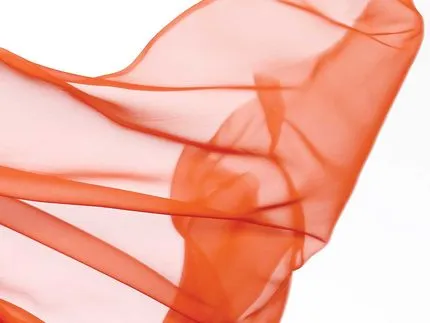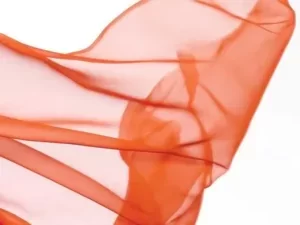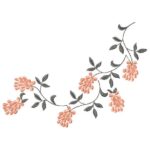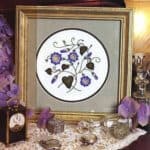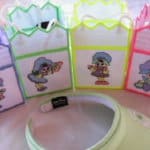Fabric Foray: Sheers. How to embroider sheer fabric . Sheers are for summer, but they can be tricky to
embroider. Read on for considerations, tips and techniques for sheer embroidery success.
Sheers encompass a variety of transparent or semi-opaque fabrics and fibers, such as pure silk chiffon,
polyester organza and nylon tulle. Some sheers are available with beautiful iridescent or metallic
finishes. While most sheers are suitable for embroidery, the stiffer varieties are the easiest to work with.
Sheers are ideal for making eveningwear, elegant daywear, bridal wear, dance costumes and special
occasion garments. Soft sheers, such as silk chiffon, are used for blouses or flowing dresses. Stiff sheers, such
as organza, are ideal for overlays and look nice with coordinating or contrasting satins and silks. Use
organza when making corsages and appliqués. Use tulle when making bridal veils or overlays for bodices. As
a general rule, choose loose, simple styles with minimal seams. For fitted garments, use sheers as overlays with a sturdier fabric, such as satin.
TIPS
• While stitching, hold the fabric slightly taut to help it glide smoothly through the machine and eliminate puckers. Hold the thread ends at the beginning of each seam to prevent the fabric from tangling in the machine throat plate. Position a piece of tissue paper along the fabric wrong side for smoother stitching, if necessary.
• Use French seams, or, for curved seams, zigzag stitch close to the stitching line and carefully trim
away the excess fabric. Choose a hand-rolled, machine stitched or serger rolled hem. For bridal
veils, stitch a serger rolled hem over a nylon fishing line to create a beautiful fluted effect. Use organza
as sheer interfacing for buttonholes.
THREAD
Use silk thread for silk chiffon and all-purpose thread for manmade fibers. Decorative thread works well on the serger for rolled hems. Rayon thread is ideal for embroidery because it’s lustrous. Iridescent metallic thread is lovely for eveningwear and is typically softer than traditional metallic threads in both color and texture.
NEEDLES
Use the smallest needle possible to avoid damaging the fabric. Size 9 or 11 needles are ideal for most sheers.
CARE
Most pure silk fabrics are washable, but test-wash a scrap of silk first to make sure the water doesn’t mar the
fabric. If the scrap isn’t damaged after washing, hand-wash the fabric to eliminate shrinkage. Hand-wash finished projects and hang them to dry. Use fabric softener to soften natural fibers and eliminate
static in manmade varieties. Use a cool dry iron on the silk setting.
STABILIZER
Use temporary stabilizer to maintain the fabric transparency and lightness. Water-soluble stabilizer is the
easiest to use because it rinses away completely. Use it as a topper on lightweight sheers to help prevent
the fabric from slipping in the hoop. Water-soluble stabilizer is available in a variety of weights for special
applications, such as embroidering lace or shaping freestanding corsages or appliqués. Fusible varieties are also available and are particularly useful for hooping silk or slippery fabrics. Use fusible water-soluble stabilizer when creating transparent layered petals or butterfly wings.
Tip:
Keep leftover water-soluble stabilizer in an airtight bag or jar to use as a brush-on starch or to shape lace.
DESIGNS
Look for designs that are lightweight and have open areas. Designs with low stitch counts and small satin stitch areas work best. Avoid dense designs with heavy fill stitches or complex, multi-colored layers.
FABRIC SELECTION
Tulle is a great base for embroidery, as it’s strong and crisp and supports stitches. The fabric works well with
lightweight lace designs because it adds a layer of support to stitches, remains transparent and maintains the
open appearance of lace embroidery. Attach colored tulle as an appliqué to coordinating chiffon, which, by
itself is too delicate to embroider. Embroider the design on the tulle and trim around the design edge once the embroidery is complete. Use invisible thread in the needle and coordinating bobbin thread, and stitch the tulle to the chiffon using a small tricot stitch.
Organza is another great base for embroidery because it’s crisp but lightweight. It’s available in a variety of colors and looks nice over satin. Make 3-D flowers using organza and a water-soluble stabilizer and
topper (A).
• Stitch several circular or petal shape designs on the organza using a satin stitch border in various sizes.
• Once the embroidery is complete, remove the fabric from the hoop and carefully trim around the design
edges.
• Place each design in water, leaving a small amount of stabilizer residue in the fabric for shaping.
• Stitch the design layers through the center to secure. Hand sew beads to the flower center, if desired.
SILK CHIFFON
Silk chiffon is the most difficult sheer to embroider because it has a soft hand and is easily damaged during
embroidery. Choose simple designs with low stitch counts for best results. Always embroider designs on a
fabric scrap first. Use water-soluble stabilizer and a topper to protect the fabric during embroidery and when
trimming jump threads.
HOW NOT TO EMBROIDER SHEERS
Avoid dense designs when embroidering sheers, as needle penetrations will tear the delicate fabric because it can’t support the weight of the finished design. When using dense embroidery designs, the fabric loses its lightness, softness and beauty. Use a topper to prevent the fabric from slipping in the hoop. Use simple, delicate designs that complement the fabric.

